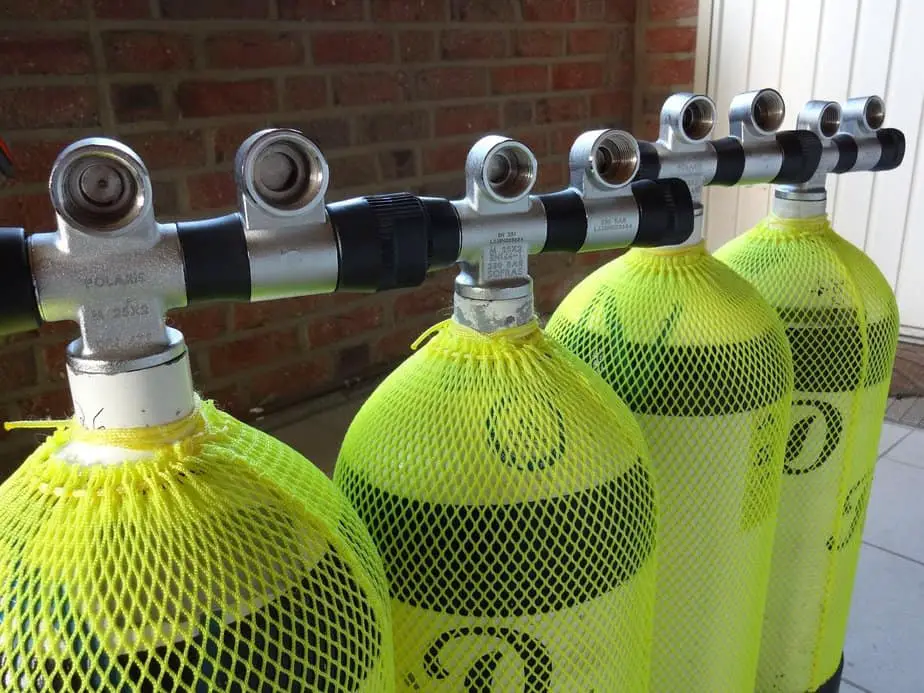Scuba tanks can last a long time if they are properly cared for. There are tanks used today that have been in service since the 70’s. The issue is, most tanks don’t last that long. Why not? Because despite how sturdy tanks are, all it takes is one drop, or a little bit of moisture, and the tank might not pass the next hydro test. These things can happen even while scuba tanks are kept in storage! That’s why it’s so important to know how to store your scuba cylinder properly.
Despite how sturdy scuba cylinders seem, they are actually quite delicate pieces of equipment that require special care. When you are putting your tank into storage until warmer weather returns, you must do the following first:
- Rinse the tank with freshwater and then completely dry it before storing it.
- Never store your tank empty or full; always leave a small amount of pressure inside (100-300 psi).
- Keep your tank in a cool, dry location, away from direct sunlight, and off of porous material like concrete.
- Keep your tank in a tank holder so that it remains in a vertical position and will not fall down easily.
- Lastly, when the tank is due for a visual inspection or hydro test, get it done even if you haven’t been using it.
Are you planning on taking a long break from scuba diving and aren’t sure what to do about your gear? If you plan on keeping your scuba cylinder, then by following all of the steps above, you will ensure that it will survive long-term storage in good condition. The rest of this article will discuss the above points in greater detail so you can do an even better job at maintaining your tank.
Rinse and dry your tanks before storage
After your final dive of the season and you’re getting ready to store your scuba gear until warm weather returns, make sure to rinse all of your gear with fresh water to remove any minerals and dirt that can accelerate corrosive damage. Of course, rinsing your gear after every dive is important, but it’s especially important if you will be putting it into long-term storage.
Store your tanks vertically
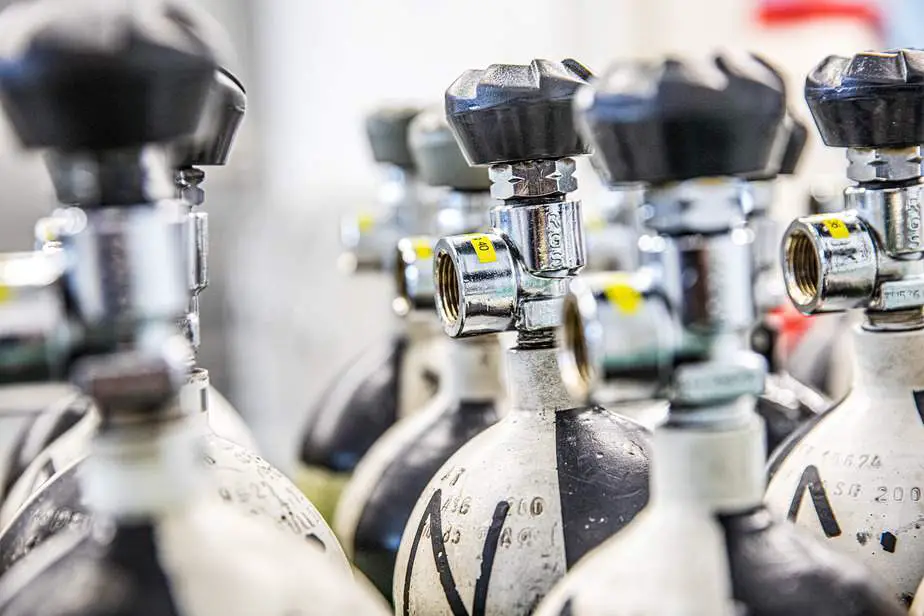
When you are storing your scuba cylinder, store it vertically, preferably in a scuba tank holder. This might seem contradictory because you may have been told to never leave your tank standing after a dive. Well, that’s because the context is different; in that context, you don’t want your tank to fall over which can dent the tank.
Now that you’ll be storing it long-term, there are a few advantages to storing a tank upright. First, you can easily secure a tank in a standing position so it won’t ever fall, and it is highly recommended that you do so.
Next, and perhaps more importantly, is that storing the tank vertically can help to avoid corrosive damage inside the tank caused by the humidity.
When a tank is stored lying on its side, that means that any water inside the tank will accumulate on the side that is facing toward the ground, and the sides are where the material is thinner. When stored vertically, the water will drip to the bottom of the tank where that material is thicker and can withstand more corrosion before the tank is rusted beyond repair.
Additionally, when the tank is laying down on its side, a greater amount of surface area is exposed to the water because it’s longer in length there. This will place a greater portion of the tank at risk of corrosion than standing upright.
Lastly, corrosive damage is much easier to detect during an inspection when it’s on the bottom instead of along the side walls.
Leave some air inside the tank
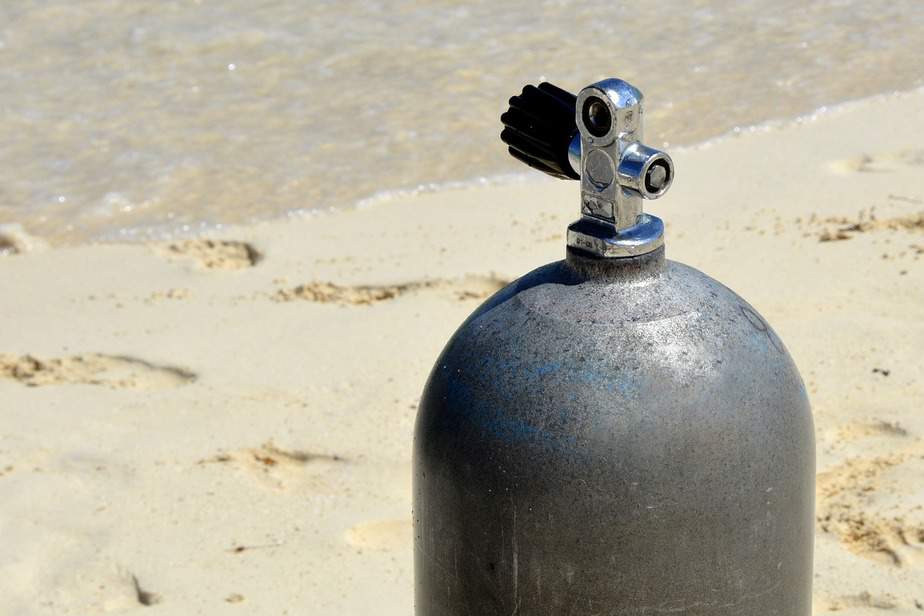
It is a mistake to put a full tank into long-term storage, because the immense pressure that the tank material must endure will reduce its lifespan, as well as increase the chance of internal rusting. Furthermore, the material may get compromised if it is exposed to moisture on the outside as well and begins to weaken, and at some point the tank might literally explode once the tank material gives out.
It is also a mistake to put a completely empty tank into long-term storage. While an empty tank would “lighten the load” on the tank material, it’s also not the optimal solution. Instead, a small amount of positive pressure should be kept inside the cylinder to help prevent small particles and humidity from entering the tank.
So how much pressure should you leave in a tank? That will depend on what the cylinder manufacturers state for your tank. Typically, the optimal pressure is between 100-300 psi (3-20 bar). So use that as a range for how much pressure to leave inside if you aren’t sure. By putting in a small amount of air, there is less of a chance for moisture to enter the tank, and you avoid the problems that a full tank faces.
Avoid heat
Make sure your tank storage area doesn’t get too hot. The tank materials will expand when exposed to heat, and contract when it’s colder. The same principle applies to the air inside, which is another reason why you shouldn’t store your tank when it’s full.
Higher temperatures will cause the pressure inside to increase, and lower temperatures will make the pressure decrease. These fluctuations will wear down the materials and thus your storage area should be ideally kept at a constant temperature.
As you’d expect, high temperatures are the biggest threat since they cause the pressure inside to increase, thereby wearing down the tank materials at an accelerated rate. In the worst case scenario, the tank will fail and release the pressurized air inside instantaneously. That’s also why you should be careful leaving your tank in a hot car for a long time.
Avoid moisture
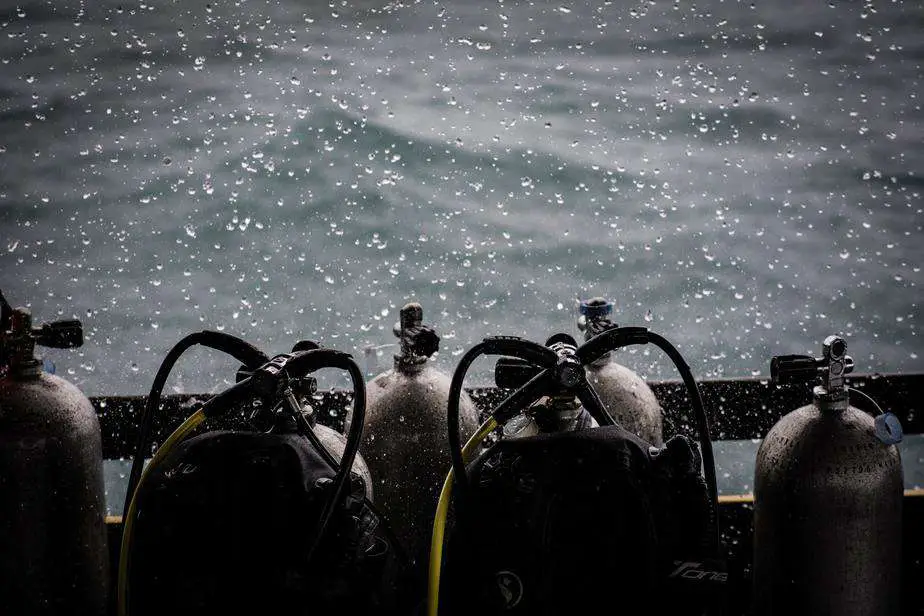
Be very careful where you store your tank. Try to place your scuba gear in a cool, dry environment, away from direct sunlight or any other heat sources.
Humidity in the air or on the surface where the tank is placed on can cause the exterior of the tank to corrode. Do not place the tank directly on wood or concrete because these are porous materials, and water can seep through them and come into contact with the tank.
As such, people who like to store their tank in the garage, the basement, or in a wood shed will be in for a surprise when they find their tank has rusted all over. Some better locations are in a closet or in a dedicated storage room with the blinds closed so sunlight won’t shine on your gear.
If the humidity is too high in your home, particularly in your basement, then we recommend purchasing a dehumidifier. You will be shocked to see how much water can be removed from the air – in the basement I have a dehumidifier with a 50 pint (23.6 L) capacity (this is the exact model I purchased), and roughly every 24 hours the bucket needs to be emptied. Ridiculous, and a good example of why scuba tanks in the basement are not a good idea.
Get your tanks serviced before the stickers expire

As you know, you will get a stamp/sticker on your tank after passing the visual inspection and hydrostatic pressure test. Your tanks should be tested before the specified dates whether you were actively using them or not. That’s right, even your scuba gear sitting dormant in storage should get tested.
This is necessary in order to ensure a long and healthy lifespan for your gear. After all, we have just discussed some of the ways moisture can still enter your scuba cylinder in storage and damage the tank. That’s why it’s crucial to continue checking up on them and getting them serviced from time to time.
Be careful during transportation
If you plan on transporting your tank via airplane or by car, there are a few things to keep in mind. We won’t really go into transportation by plane – read the TSA rules on bringing compressed air cylinders.
As for transporting your cylinders by car, it is crucial that they are placed on the bottom and strapped down. Due to the cylindrical shape of a scuba tank, they can easily roll around, making them dangerous to put on top of other items. Furthermore, a full tank can be quite heavy, particularly aluminum tanks. You wouldn’t want that rolling around your car or dropping on somebody’s foot.
Another concern is any damage to the tank itself. As discussed, a dented or scratched tank might not have the integrity to safely hold all of the compressed gasses inside anymore. That’s why it’s best if they are placed on the bottom and ideally strapped in place so it doesn’t shift around, damaging the car and the tank itself.
Using a tank after long-term storage
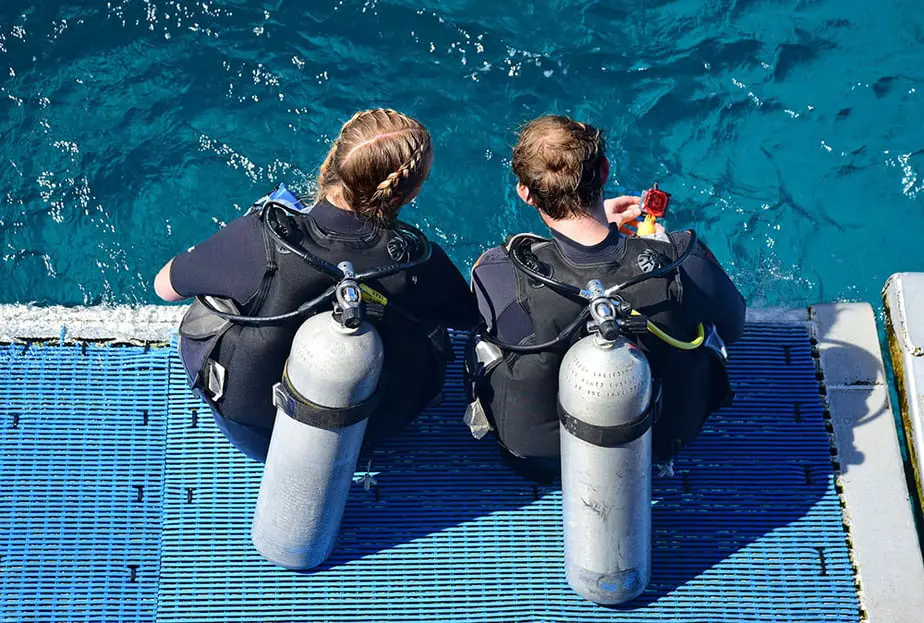
So, your long hiatus is finally over and it’s time to dust off your scuba gear and get back into it. Are you sure that your scuba tank is still safe to use? If you’ve been getting it visually inspected yearly and it’s passed every time, that’s a good sign. However, the big test is the hydro, and also from the time since your last inspection until now, there’s a possibility your tank was damaged in some way.
If you have an old tank that’s been sitting unused that hasn’t been getting serviced, how can you tell it’s still safe to use? Getting it tested costs money, and the result might be that the tank is condemned, so here are a few tips to follow so that you don’t waste your time or money on a bad tank.
Note: The tips provided below can also be used to help you inspect a used scuba tank that you plan on buying.
Inspect the exterior for damage. You are looking for any signs of corrosion which is not necessarily a dealbreaker, but it should give you some pause. Don’t forget to remove the boot and inspect the bottom of the tank for rust as well. Hopefully you (or somebody else) didn’t accidentally knock over the tank at some point either, because a dropped tank is unlikely to pass inspection.
Empty the tank. Have you forgotten to leave 100-300 psi of pressure inside? If the tank was completely empty, check for any obvious moisture or corrosion inside the tank. You won’t do as good of a job as a real visual inspection, but if the situation is bad enough, you won’t need to because the tank is obviously going to fail.
Check the valve. Look for any signs of damage to the valve; it’s not made of very sturdy material, so it’s easy for it to get dented if other equipment has come into contact with it or if the tank was dropped. Try turning it to see how smooth it turns. If it’s stiff, you’ll have to get it serviced or replaced outright.
Check the O-ring in the valve. Has it dried out or lost its shape? Honestly, O-rings are pretty easy and cheap to replace, so you might just want to replace it regardless. If you forget to do this step and the O-ring was in bad condition, then you risk it blowing out at depth and leaving you without air.
Is the burst disk intact? This is a special point if you are buying a used tank. Burst disks are designed to burst if the tank is overfilled. If you have been getting it inspected yearly, this will be checked for you. If the burst disk is no longer patent, you will have to replace it which is an additional fee on top of the inspection.
Why is tank maintenance so important?
After having read all of the above (or perhaps you couldn’t be bothered to and skipped straight to this section), you might be wondering, “Is it really that important to do all of these steps? What’s the worst that could happen if I skip a few of them?”
Well my friend, you’ve probably seen tanks in movies violently explode, right? That’s how Bruce, the infamous shark in Jaws, was taken out. “But that stuff only happens in movies”, you say. “Tanks don’t just go around exploding in real life!” That’s where you’d be mistaken.
There’s a reason why tanks explode in movies; this risk is based on real life, because everything terrifying that has ever happened in movies was inspired by real life. They say that truth is scarier than fiction, and guess what? Scuba tanks have exploded in real life with human casualties. Even if you lose a few limbs, consider yourself lucky if you survive because many don’t (not that there are many to begin with). This is NOT something to take lightly.
When you compress so much gas into a scuba tank, the pressure inside is immense. If the tank were to get damaged and all that pressure released at once, it would cause an explosion like in the movies.
Improper tank maintenance and neglect can cause the tank to be exposed to moisture and corroded by it. Also, tanks are quite heavy and if one were to fall down, it could easily dent the side walls. These things can happen if you fail to store your scuba tank properly!
Basically, if the integrity of the scuba cylinder material is compromised, then it’s like a ticking time bomb just waiting to go off. This was actually one of my first irrational fears of scuba diving – not of drowning or getting attacked by sharks, but rather the tank possibly exploding on my back because I dented it earlier.
The point of this section is: don’t take tank maintenance and storage lightly. You could be saving your future self from a deadly accident.
Last update on 2024-07-16 / Affiliate links / Images from Amazon Product Advertising API

